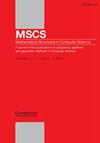用图形变换保持几何建模的一致性
IF 0.9
4区 计算机科学
Q4 COMPUTER SCIENCE, THEORY & METHODS
引用次数: 2
摘要
标记图特别适合于在基于拓扑的几何建模环境中表示对象。因此,使用图变换理论来实现建模操作并检查其一致性。本文定义了一类专门用于嵌入计算的图转换规则。对象在这里被定义为标记图的特定子类,其中弧标签编码其拓扑结构(即,细胞细分:顶点,边缘,面),节点标签编码其嵌入(即,相关数据:顶点位置,面颜色,体积密度)。对象一致性是通过标记约束来定义的,这些约束必须通过修改拓扑和/或嵌入的建模操作来保持。专用的图变换变量允许我们从底层拓扑结构(例如,收集人脸的所有点)访问现有的嵌入,以便使用用户提供的函数(例如,计算几个点的重心)计算新的嵌入。为了确保所定义操作的安全性,我们在规则上提供了保留对象一致性约束的语法条件。本文章由计算机程序翻译,如有差异,请以英文原文为准。
Preserving consistency in geometric modeling with graph transformations
Labeled graphs are particularly well adapted to represent objects in the context of topology-based geometric modeling. Thus, graph transformation theory is used to implement modeling operations and check their consistency. This article defines a class of graph transformation rules dedicated to embedding computations. Objects are here defined as a particular subclass of labeled graphs in which arc labels encode their topological structure (i.e., cell subdivision: vertex, edge, face) and node labels encode their embedding (i.e., relevant data: vertex positions, face colors, volume density). Object consistency is defined by labeling constraints which must be preserved by modeling operations that modify topology and/or embedding. Dedicated graph transformation variables allow us to access the existing embedding from the underlying topological structure (e.g., collecting all the points of a face) in order to compute the new embedding using user-provided functions (e.g., compute the barycenter of several points). To ensure the safety of the defined operations, we provide syntactic conditions on rules that preserve the object consistency constraints.
求助全文
通过发布文献求助,成功后即可免费获取论文全文。
去求助
来源期刊

Mathematical Structures in Computer Science
工程技术-计算机:理论方法
CiteScore
1.50
自引率
0.00%
发文量
30
审稿时长
12 months
期刊介绍:
Mathematical Structures in Computer Science is a journal of theoretical computer science which focuses on the application of ideas from the structural side of mathematics and mathematical logic to computer science. The journal aims to bridge the gap between theoretical contributions and software design, publishing original papers of a high standard and broad surveys with original perspectives in all areas of computing, provided that ideas or results from logic, algebra, geometry, category theory or other areas of logic and mathematics form a basis for the work. The journal welcomes applications to computing based on the use of specific mathematical structures (e.g. topological and order-theoretic structures) as well as on proof-theoretic notions or results.
 求助内容:
求助内容: 应助结果提醒方式:
应助结果提醒方式:


